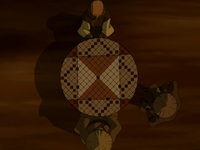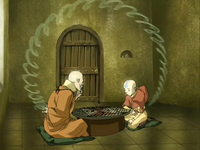(small fix) |
No edit summary |
||
| Line 1: | Line 1: | ||
| − | {{Icons|p-move|Order of the White Lotus}} |
+ | {{Icons|p-move|Neutral|Order of the White Lotus}} |
{{quote|neutral|I always tried to tell you that Pai Sho is more than just a game.|[[Iroh]] to [[Zuko]] in "[[The Desert]]".}} |
{{quote|neutral|I always tried to tell you that Pai Sho is more than just a game.|[[Iroh]] to [[Zuko]] in "[[The Desert]]".}} |
||
Revision as of 23:07, 5 September 2012
| "I always tried to tell you that Pai Sho is more than just a game." |
| — Iroh to Zuko in "The Desert". |

A game of Pai Sho.
Pai Sho is a two-player strategy game and is quite popular throughout the World of Avatar, as many people from all four nations have been seen playing it. It still remains popular even after the Hundred Year War. Pai Sho is also used by the secretive Order of the White Lotus to identify its members.[1]
Rules

An overhead view of a Pai Sho game.
The large, circular board is split into twelve sections divided by an 18x18 grid of colored squares. Round tiles are used as pieces; each tile has a different image. Players receive a certain number of tiles which are placed and moved around the board.
White lotus tile
The White Lotus tile.
The white lotus tile, like all Pai Sho tiles, is a round, black, circular piece one-and-a-half inches in diameter. It is identified by the image of a large white flower that takes up most of the tile. According to Iroh, many underestimate its importance.[2]
Order of the White Lotus
In a bar at the Misty Palms Oasis, Iroh played a game with another member, Fung, as a way of identifying himself as part of the society. The key to recognition between members includes scripted dialogue revolving around the opening move of placing a certain tile, the white lotus, in the center of the board, followed by the rapid placement of pieces in an exact pattern that mirrors the central piece.[1]
Notable players

Trivia
- Pai Sho bears a resemblance to Go, Chinese Checkers, Straight checkers, and Xiangqi.
- The name of the game bears resemblance to a Tibetan game called Sho-pa, although Sho-pa, in reality, is a gambling game and is not at all similar to chess or checkers.
- The name bears an even greater resemblance to the Chinese tile game, Pai gow.
- According to Zuko, Pai Sho can also be used to gamble.[1]
- There is a giant Pai Sho table in the Western Air Temple.[7]